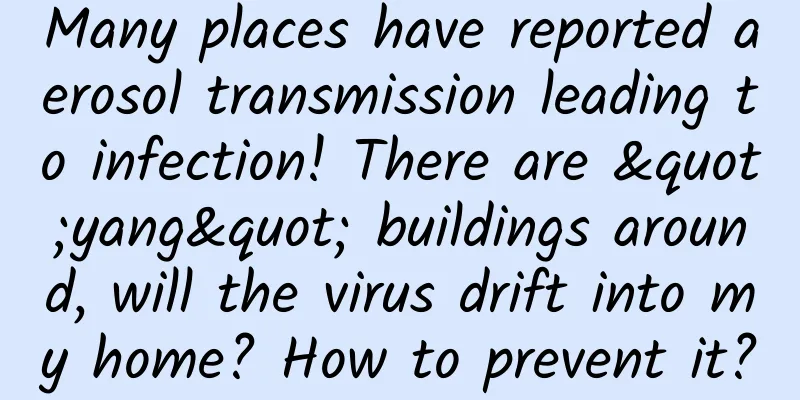Many places have reported aerosol transmission leading to infection! There are "yang" buildings around, will the virus drift into my home? How to prevent it?

|
Recently, many places including Ningbo, Zhejiang and Zaozhuang, Shandong have reported cases of new coronavirus infection caused by aerosol transmission, involving underground parking lots, outdoors, etc. During this round of COVID-19 epidemic in Taierzhuang District, a resident of the district went outdoors to dig wild vegetables without wearing a mask and was infected by an asymptomatic infected person who was not wearing a mask and was staying there at the same time. After epidemiological investigation and analysis, it was determined that the infection was caused by aerosol transmission. Previously, Ningbo Center for Disease Control and Prevention released a message on the evening of April 10: It was reported that a local confirmed case drove a car (with the windows open and without wearing a mask) into an underground parking lot. During the same time period, two other subsequent cases stayed in the parking lot without wearing masks, posing the possibility of infection through aerosol transmission. Then, there were rumors online that: The novel coronavirus spreads along the wind, causing a "chain of positive cases in the building" Many netizens began to worry: Is opening a window risky?! Surrounded by "Yang" buildings Will the virus drift into my home through the windows? Relevant experts answered the questions↓↓↓ 01 Keep windows open and air flowing Minimizes the risk of aerosol transmission At the press conference of the State Council's Joint Prevention and Control Mechanism held on March 25, Wang Guiqiang, director of the Department of Infectious Diseases at Peking University First Hospital, said that according to the Diagnosis and Treatment Plan for Novel Coronavirus Pneumonia (Trial Ninth Edition) released on March 14, the new coronavirus can be transmitted through aerosols in a relatively closed environment. However, just as "talking about toxicity without considering the dose is just hooliganism", talking about aerosol transmission also requires considering the concentration issue. Wang Xinyu, deputy chief physician of the infectious department of Huashan Hospital affiliated to Fudan University, said that if the infected person is outdoors, the high concentration of aerosols discharged by the infected person can be quickly diluted by fresh air due to the effect of air flow, and will not reach the concentration that can infect the human body, and will not pose such a threat. In an indoor environment with poor air circulation, high concentrations of aerosols may exist for a long time, and even if the infected person has left the space, people who enter later may still be infected. For this reason, keeping windows open and air flowing can minimize the risk of aerosol transmission. On the other hand, if aerosols containing high concentrations of virus particles in the room are blown outdoors through open windows, they are quickly diluted and are unlikely to cause "cross-building" transmission. On April 11, medical staff at the Fangcang Hospital in the Expo Exhibition Center discussed their work. Xinhua News Agency (Photo by Liu Xiaojing) 02 Expert reminder: These two situations require attention ■ "In some residential areas, the distance between buildings is so close that a person can climb from the window of one building to the window of another building opposite. In this case, if the windows on both sides are opened at the same time, there is theoretically a possibility that the aerosol is not fully diluted by the outdoor air and thus 'crosses the building' into another building. However, as long as the air continues to circulate, the aerosol will still be quickly diluted to the point where it has no infectious ability." ■ In addition, some residences have windows that open onto interior corridors, which may also present a risk of virus transmission within the same building. Wang Xinyu said that the medical community has not yet reached a clear conclusion that the new coronavirus can spread across buildings, and there is only a small theoretical possibility. "This small possibility should not be exaggerated and cause panic." On March 26, volunteers sorted and disinfected express items outside the sealed-off community. (Photo by Xinhua News Agency reporter Li Ang) One picture to understand Aerosol transmission Comprehensive sources: Science and Technology Daily, People's Daily Online, News Broadcast, Guangming Daily, Health Times, Fujian Daily, Ningbo Center for Disease Control and Prevention, etc. |
>>: Is the refrigerator full of ice because it is not filled with enough vegetables?
Recommend
A veteran operator who achieved tens of millions of app downloads in one year: practical strategies from ordinary operations to top operations!
The operations director who achieved 10 million ap...
Is the effect of bidding promotion declining? You must analyze these 8 factors
Nowadays, most of our SEM promotions revolve arou...
Attention! Heavy rainfall in Beijing, Tianjin and Hebei reappears. How to prevent and respond scientifically?
At 10 a.m. today (11th), the Central Meteorologic...
The S8 that doesn't explode still can't be the savior. Users will teach Samsung a lesson.
On March 29, Samsung released its long-awaited fl...
Why has the radio and television industry fallen to a state of decline even worse than Chinese football?
I know that the following words will certainly le...
A complete list of essential tools for app promotion!
APP submission to large channel market: App Store...
Must you buy Q5 or X3? Jeep Grand Commander is more suitable for mountaineering
Recently, the application pictures of GAC Fiat Ch...
Cook's coming out on homosexuality: Fireworks of different colors
Cook finally came out. After years of suspicion, ...
Do you know how to ask Handler questions at the elementary, intermediate and advanced levels?
Handler is a message processing mechanism in Andr...
Excellent! The driver's scientific operation saved 19 passengers!
Recently, Zhuzhou, Hunan Beijing-Hong Kong-Macao ...
Brake failure and reduced driving range led to 20 BYD electric buses being returned and orders canceled by the US
According to foreign media reports, a batch of BY...
Where will diesel cars go? Shikoku mayors say they will be banned from the road
Recently, the mayors of Paris, Athens, Madrid and...
How can we reduce the uninstall rate of APP users?
There is a question that has been bothering App d...
When the whole world is talking about Swift open source - 2015 Objective-C new features
Overview Since the launch and open source of Swif...
Can robots give birth to babies? Are they considered living organisms? Experts explain
Recently, American researchers discovered a new w...









